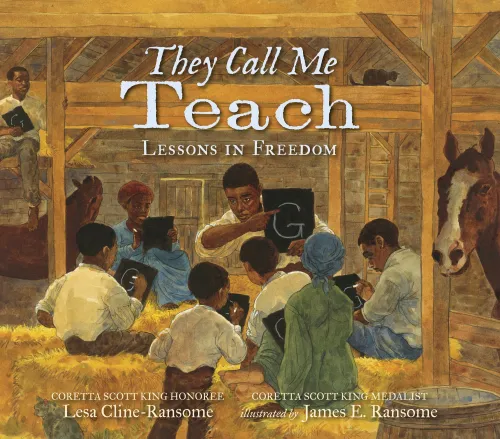Share this Book
In They Call Me Teach: Lessons in Freedom, Teach uses and shares his reading and writing abilities every day of the week. After reading the book aloud, talk with students about what literacy is, what is so remarkable about Teach’s ability to read and write, and their own literacy experiences. How are you literate? Do you value your literacy? Why or why not?
Invite students to reflect on how and where they use reading and writing every day—at school, at home, in their communities, or for fun. Encourage them to recognize and celebrate the many ways they are literate by having them write a poem that shows how reading and writing impacts their daily lives. Following the format of They Call Me Teach, have students include a line or stanza for each day of the week that describes how they use reading or writing on that day—whether it’s reading instructions for a game, writing in a journal, doing homework, following a recipe, or enjoying a favorite book.
Once poems are complete, celebrate student voices by dedicating time each day of the week to sharing their work. Choose a few students each day to read their poems—or one day’s stanza—aloud to the class, giving everyone a chance to hear the variety of ways reading and writing shape daily life.
Poems would also make a wonderful display for Read Across America or a great class poetry book to share with families or the school community.
Questions for Discussion or Reflective Writing
- What does education mean to Teach and those he teaches and helps? What does education mean to you?
- What does freedom mean to Teach? How is education a form of freedom? What does it mean to have a right to an education?
- What is Teach’s routine? When did he teach? Why did he need to teach at those times?
- Why was it dangerous for Teach to know how to read and write and to use and share that knowledge? How were enslaved people treated in the United States? What would be the punishment for Teach if he was found reading or writing outside the store?
- How did the illustrations help convey what was secretly taking place? How does the use of warm tones in the illustrations make you feel about what you are reading?
Related Resources
They Call Me Teach Discussion Guide from Candlewick Press
Lesa Cline-Ransome and James E. Ransome discuss They Call Me Teach: Lessons in Freedom video from Candlewick Press
Past Present with Lesa Cline-Ransome: What is the true meaning of Freedom? from KidLit TV
Teaching Hard History: Grades K-5 from Learning for Justice
More Titles to Try
-
Dave the Potter: Artist, Poet, Slave
by Laban Carrick Hill, illustrated by Bryan Collier
-
Light in the Darkness: A Story about How Slaves Learned in Secret
by Lesa Cline-Ransome, illustrated by James Ransome
-
Midnight Teacher: Lilly Ann Granderson and Her Secret School
by Janet Halfmann, illustrated by London Ladd
-
The Oldest Student: How Mary Walker Learned to Read
by Rita L. Hubbard, illustrated by Oge Mora
-
Poet: The Remarkable Story of George Moses Horton
by Don Tate
Stay on top of current education news


